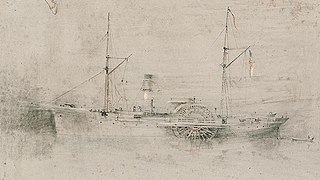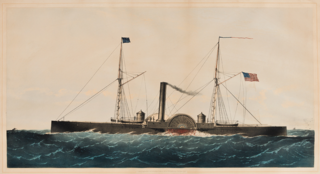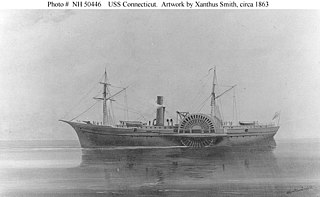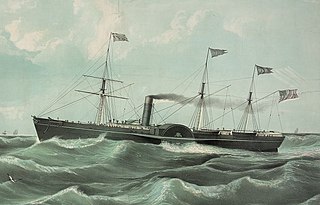
The first USS Pawnee was a sloop-of-war in the United States Navy during the American Civil War. She was named for the Pawnee Indian tribe.

USSKeystone State was a wooden sidewheel steamer that served in the Union Navy during the American Civil War. She was a fast ship for her day and was used effectively to blockade Confederate ports on the Atlantic coast. She participated in the capture or destruction of 17 blockade runners. In addition to her military service, Keystone State had a lengthy commercial career before the war. Renamed San Francisco, she also sailed commercially after the war. The ship was built in 1853 and scrapped in 1874.

USS Fort Jackson was a wooden sidewheel steamer in the United States Navy during the American Civil War. She was successful in enforcing the Union blockade of Confederate ports, capturing five ships carrying contraband. She participated in the battles for Fort Fisher, which effectively closed the port of Wilmington, North Carolina to the Confederacy. Most notably, the surrender of Confederate forces in Texas was signed aboard the ship, formally ending the Civil War in that portion of the country.

The first USS Tuscarora was a Mohican-class sloop of war in the United States Navy during the American Civil War.

USS James Adger was a sidewheel steamer in the Union Navy during the American Civil War. She retained her former name.

USS Santiago de Cuba was a side-wheel steamship acquired by the Union Navy during the first year of the American Civil War. She was outfitted as a gunboat with powerful 20-pounder rifled guns and 32-pounder cannon and was assigned to the Union blockade of the Confederate States of America. She was notably successful in this role, capturing several blockade runners. Her last major action of the war was the assault on Fort Fisher, during which seven of her crew won the Medal of Honor.

The first USS Nereus, a screw steamer built at New York in 1863, was purchased by the Union Navy from William P. Williams on 5 October 1863; and commissioned at New York Navy Yard 19 April 1864, Commander John C. Howell in command.
USS Home was a large steamship purchased by the Union Navy during the American Civil War. She was placed into service as a hospital ship assigned to support the fleet blockading the ports of the Confederate States of America.
The second USS Kensington was a steamship in the United States Navy.

USS Vanderbilt was a heavy (3,360-ton) passenger steamship obtained by the Union Navy during the second year of the American Civil War and utilized as a cruiser.

USS Osceola was a wooden, sidewheel Sassacus-class gunboat which saw combat with the Union Navy in the American Civil War. She was designed with shallow draft and double-ends specifically to allow her to operate in the narrow rivers and inlets along the Confederate coast. She was well suited to this role and took part in major battles on the James and Cape Fear Rivers.

USS Grand Gulf was a wooden-hulled, propeller-driven steamer acquired by the Union Navy during the American Civil War. She was effective in performing blockade duty, and captured a number of Confederate blockade runners.

USS Young America was a Confederate steamer captured by the Union Navy’s blockade vessels, and subsequently placed in-service in the Union Navy during the American Civil War.

USS Connecticut was a large steamer acquired by the Union Navy during the American Civil War. Her primary task was to prevent ships from penetrating the Union blockade of Southern ports.
USS Western World was a ship acquired by the Union Navy during the American Civil War. She was used by the Navy to patrol navigable waterways of the Confederacy to prevent the South from trading with other countries.
USS State of Georgia was a large steamer with powerful guns acquired by the Union Navy during the American Civil War. State of Georgia, with her crew of 113 sailors and officers, was used by the Union Navy as a gunboat in its blockade of Confederate waterways.
USS Guard was a fourth-class ship-rigged sailing vessel, armed with four 8-inch (203 mm) Dahlgren guns and one 21-pdr howitzer, acquired by the Union Navy during the American Civil War.

Western Metropolis was a wooden side-wheel steamship built in 1863. She was chartered by the quartermaster corps of the Union Army during the American Civil War to provide logistical support. As a transport ship, she was unarmed, but nonetheless captured a Confederate blockade runner. After the war, she was in commercial service for another ten years. Notably, she made five trans-Atlantic voyages and brought several thousand immigrants to the United States from Northern Europe. She was idled in 1875, and had her engine removed in 1878. Her ultimate fate is unknown.

Star of the South was a wooden-hulled, propeller-driven steamship launched in 1853. She was one of the first mechanically reliable and economically profitable propeller-driven steamships. Her success foretold the end of paddlewheel propulsion on ocean-going steamships.

Atlantic was a wooden-hulled, side-wheel steamship launched in 1849. She was conceived as a part of an American fleet which would break the monopoly that European steamers, notably the Cunard Line, had on trans-Atlantic trade. She was the most successful of the Collins Line ships, and one of the most luxurious vessels of her day, but the company went bankrupt in 1858.















